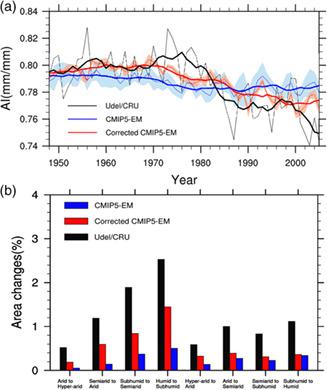当前位置:
X-MOL 学术
›
Int. J. Climatol.
›
论文详情
Our official English website, www.x-mol.net, welcomes your
feedback! (Note: you will need to create a separate account there.)
Bias-corrections on aridity index simulations of climate models by observational constraints
International Journal of Climatology ( IF 3.5 ) Pub Date : 2021-07-01 , DOI: 10.1002/joc.7279 Haipeng Yu 1, 2 , Qiang Zhang 2 , Yun Wei 3 , Chenxi Liu 3 , Yu Ren 3 , Ping Yue 2 , Jie Zhou 3
International Journal of Climatology ( IF 3.5 ) Pub Date : 2021-07-01 , DOI: 10.1002/joc.7279 Haipeng Yu 1, 2 , Qiang Zhang 2 , Yun Wei 3 , Chenxi Liu 3 , Yu Ren 3 , Ping Yue 2 , Jie Zhou 3
Affiliation

|
Aridity Index (AI) indicates the balance between water supply and water demand on the atmosphere–land interface. Despite continuous improvements, coupled climate models still have significant systematic errors in simulating AI in terms of temporal and spatial variabilities. One of the approaches to bias-correct simulations is extracting the linear relationship between historical observations and model outputs by utilizing the empirical orthogonal function (EOF). In this study, the methodology of ensemble EOF-based bias-correction by observational constraints is developed based on previous bias-correction approach, with the improvement on seeking the optimal combinations of the leading modes with sensitivity test and replacing the certain correction with the ensemble means of optimal members. In verification, the ensemble mean of Coupled Model Intercomparison Project phase 5 (CMIP5-EM) is bias-corrected towards the CPC/GLDAS observations, and the extracted leading modes present high correlations with internal climate variability. By cross-validation and posteriori independent validation of hindcasts over the historical period (1948–2005), the ensemble EOF-based bias-correction could better present spatial patterns compared to the CMIP5-EM after systematic bias-correction, as indicated by the anomaly correlation and the root mean square error. The verifications also indicate that the temporal variability in aridity over different dryland regions is much closer to that in the observations and that the dryland subtype changes are improved significantly by bias-corrections. Besides, another observational dataset of UDel/CRU is applied to assess the uncertainty on different datasets and the improvement on skill scores is robust. The above results verify that the ensemble EOF-based bias-corrections provide better reference for assessing and projecting global aridity changes by climate models.
中文翻译:

通过观测约束对气候模型干旱指数模拟的偏差校正
干旱指数(AI)表示大气-陆地界面上的供水和需水之间的平衡。尽管不断改进,耦合气候模型在模拟 AI 的时空变异性方面仍然存在显着的系统误差。偏差校正模拟的一种方法是利用经验正交函数 (EOF) 提取历史观察和模型输出之间的线性关系。本研究在以往偏差校正方法的基础上,发展了基于观测约束的集合EOF偏差校正方法,改进了通过灵敏度测试寻找主导模态的最佳组合,并用集合代替某些校正。最优成员的手段。在验证中,耦合模式比对项目第 5 阶段 (CMIP5-EM) 的集合平均值针对 CPC/GLDAS 观测值进行了偏差校正,提取的主导模式与内部气候变率具有高度相关性。通过对历史时期(1948-2005)后报的交叉验证和后验独立验证,与系统偏差校正后的 CMIP5-EM 相比,基于 EOF 的整体偏差校正可以更好地呈现空间模式,如异常所示相关性和均方根误差。验证还表明,不同旱地地区干旱的时间变异性与观测值更接近,并且通过偏差校正显着改善了旱地亚型变化。除了,UDel/CRU 的另一个观测数据集用于评估不同数据集的不确定性,并且技能分数的提高是稳健的。上述结果验证了基于集合EOF的偏差校正为气候模型评估和预测全球干旱变化提供了更好的参考。
更新日期:2021-07-01
中文翻译:

通过观测约束对气候模型干旱指数模拟的偏差校正
干旱指数(AI)表示大气-陆地界面上的供水和需水之间的平衡。尽管不断改进,耦合气候模型在模拟 AI 的时空变异性方面仍然存在显着的系统误差。偏差校正模拟的一种方法是利用经验正交函数 (EOF) 提取历史观察和模型输出之间的线性关系。本研究在以往偏差校正方法的基础上,发展了基于观测约束的集合EOF偏差校正方法,改进了通过灵敏度测试寻找主导模态的最佳组合,并用集合代替某些校正。最优成员的手段。在验证中,耦合模式比对项目第 5 阶段 (CMIP5-EM) 的集合平均值针对 CPC/GLDAS 观测值进行了偏差校正,提取的主导模式与内部气候变率具有高度相关性。通过对历史时期(1948-2005)后报的交叉验证和后验独立验证,与系统偏差校正后的 CMIP5-EM 相比,基于 EOF 的整体偏差校正可以更好地呈现空间模式,如异常所示相关性和均方根误差。验证还表明,不同旱地地区干旱的时间变异性与观测值更接近,并且通过偏差校正显着改善了旱地亚型变化。除了,UDel/CRU 的另一个观测数据集用于评估不同数据集的不确定性,并且技能分数的提高是稳健的。上述结果验证了基于集合EOF的偏差校正为气候模型评估和预测全球干旱变化提供了更好的参考。











































 京公网安备 11010802027423号
京公网安备 11010802027423号